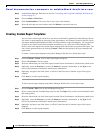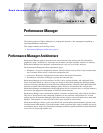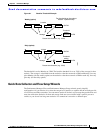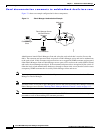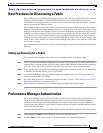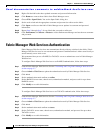
CHAPTER
Send documentation comments to mdsfeedback-doc@cisco.com.
6-1
Cisco MDS 9000 Family Fabric Manager Configuration Guide
OL-6965-03, Cisco MDS SAN-OS Release 2.x
6
Performance Manager
The primary purpose of Fabric Manager is to manage the network. A key management capability is
network performance monitoring.
This chapter contains the following section:
• Performance Manager Architecture, page 6-1
Performance Manager Architecture
Performance Manager gathers network device statistics historically and provides this information
graphically using a web browser. It presents recent statistics in detail and older statistics in summary.
Performance Manager also integrates with external tools such as Cisco Traffic Analyzer.
The Performance Manager has three operational stages:
• Definition—Uses two configuration wizards. The Flow Wizard sets up flows in the switches while
the Collection Wizard create a collection configuration file.
• Collection—Reads the configuration file and collects the desired information.
• Presentation—Generates web pages to present the collected data.
Performance Manager can collect statistics for ISLs, hosts, storage elements, and configured flows.
Flows are defined based on a host-to-storage (or storage-to-host) link. Performance Manager gathers
statistics from across the fabric based on collection configuration files. These files determine which SAN
elements and SAN links Performance Manager gathers statistics for. Based on this configuration,
Performance Manager communicates with the appropriate devices (switches, hosts, or storage elements)
and collects the appropriate information at fixed five-minute intervals.
Performance Manager uses a round-robin database to hold the statistical data collected from the fabric.
This data is stored based on the configured parameters in the collection configuration file. At each
polling interval, Performance Manager gathers the relevant statistics and stores them in the round-robin
database. This database is a fixed size and will not grow beyond its preset limits.
Performance Manager creates a series of archived data to hold summarized information present in the
real-time round-robin database. This archived data is used to generate daily, weekly, monthly, and yearly
consolidated reports. In this way, Performance Manager maintains significant historical data without the
cost of an ever-increasing database size.








